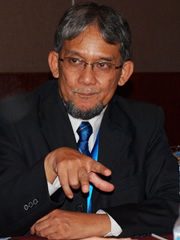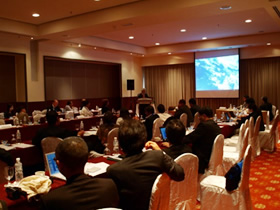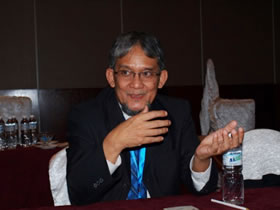Interview with Prof. Dr. Mohd Alauddin Mohd Ali, Director, Institute of Space Science, Universiti Kebangsaan Malaysia (UKM), at APRSAF-19 in Kuala Lumpur (Dec 2012)
The APRSAF Secretariat interviewed Prof. Dr. Mohd Alauddin Mohd Ali, Director, Institute of Space Science, Universiti Kebangsaan Malaysia (UKM), at APRSAF-19 in Kuala Lumpur, Malaysia, in December 2012. As a Malaysian co-chair of the APRSAF-19 Space Environment Utilization Working Group (SEU WG), he talked about the microgravity experiment activity in Malaysia, which was started when the Malaysian astronaut, Angkasawan, went to the International Space Station (ISS) in October 2007.
Secretariat: What was your background before you were involved in the microgravity experiment?

S: Is the microgravity experiment rather new to you?
Yes, but because there has been an increasing number of Malaysian initiatives in microgravity work from the experience of the Angkasawan program, we were persuaded in being involved. Also, we had a lot of help from Dr. Mazlan, Head of the United Nations Office for Outer Space Affairs (UNOOSA). We agree with Dr. Mazlan's ideas that although Malaysia cannot send an Angkasawan or astronaut every few years, we could always send some experiments or some work through other channels. That is why we feel that we should always be working in this area.

S: Do you cover all the fields of microgravity activity in Malaysia?
No. The space agency, ANGKASA, is the coordinator. I am from the university, and we contribute to the research based on our expertise. We also have other universities in Malaysia, which are also involved. The main ones are the Universiti Putra Malaysia, UPM and the Universiti Teknologi MARA, UiTM, in addition to our university, National University of Malaysia, UKM.
S: Nevertheless, you are one of the few players.
Yes, but in Malaysia most of the space activity is still coordinated through our space agency. We are working very closely with them. In fact, we are collaborating with them on most of our institute's major activities for its successful implementation.
S: I think Malaysia has seen stable progress in the space activity field. Among those activities, what does the microgravity experiment mean to Malaysia?
We are dealing with the whole scope of space studies and activities, and microgravity is one of them. But, again, because of the experiments done with the Angkasawan program, microgravity seems to have become one of the main focuses of the space projects. In particular, with the help of JAXA, I think we are able to continue the work effectively.
S: Among the many fields of space activities, microgravity is a difficult field because you do not see concrete results for many years. Of course, it is very important for the science and the scientist, but the result is very fundamental and important for human beings.

Our institute faces a dilemma because we want to encourage people to work on this, but of course, the government and public are demanding immediate outputs.
S: I think the outreach activity is especially important for the microgravity or space utilization activity.
I would say that encouraging education and public awareness is easy through microgravity experiments because it creates interest, especially among young students. I think our institute is quite successful in promoting that.
S: For example, the space seed program (SSAF) is very useful for the scientist and for the students and teachers.
Yes. Participants of the program were able to experience a fundamental process of the space experiment, although the process itself looks simple, which is mainly sending some seeds to space. In addition, the experiment could connect our population to space advancement.
S: Apart from those activities of Malaysia, how do you feel about your first time at the APRSAF and about the two-day working group?
Actually, when our space agency invited me, I did not hesitate to accept the invitation because I felt the APRSAF activities were part of our university’s goals to achieve higher exposure. Actually, I was invited last year to Singapore by the agency, but I was unable to go. Thus, it is very convenient that this year it has been organized in Malaysia. Having spent the two-day working group session, I was informed in detail of the development of activities by other countries, which are mostly new to me.
S: What is your impression of your colleagues from other countries?
Actually, different countries have different developments and focus. For example, Korea had to develop a drop tower themselves. We are also thinking of making the drop tower, and perhaps we could think of designing our own from the example shown by Korea. It is something that interests us. Further, the video on “Try Zero G” (orbital experiments for education) gives the view that the experiment does not have to be very complicated. Something simple, and some ideas even from schoolchildren could be interesting.
S: I think "Try Zero G," especially for children and youth; makes it easy for them to understand microgravity, stimulates them, and helps them come up with various ideas.

It could be something simple that could generate more ideas and stimulate the younger generation to come up with their own ideas. I was also interested in the new facilities in Kibo for launching small satellites, and I have been discussing our possible involvement with the ANGKASA staff. This is probably one area that should also prove beneficial.
S: Thank you.